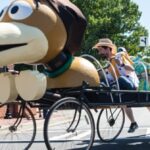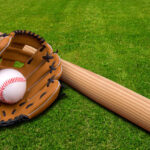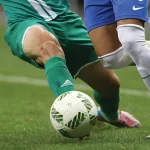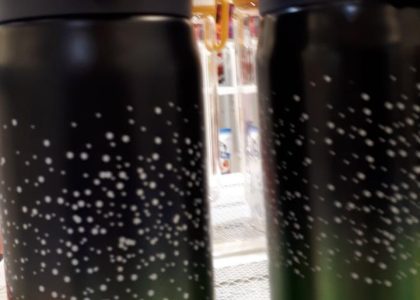Presentation on the topic: Decorative, song and wintering birds. Presentation on the topic "birds" for the middle group of kindergarten Educational areas: cognitive development, speech development,
Presentation on the topic: Decorative, song and wintering birds. Presentation on the theme "birds" for the middle group of kindergarten
Educational areas: cognitive development, speech development, social and communicative development, physical development.
Topic: Acquaintance with decorative birds.
Program tasks:
Educational:
give children ideas about decorative birds.
expand the vocabulary of children through the names of birds.
Developing:
to develop the desire and interest in children to study the features of decorative birds.
Educational:
to educate children in an emotional and caring attitude towards birds.
Equipment and materials: illustrations depicting decorative birds; sound recording of bird voices; cube with the image of decorative birds; audio recording of physical minutes; multimedia presentation; a laptop.
Preliminary work: acquaintance with various birds, including decorative ones; bird watching.
Motivational-orienting stage
Children, today we have an unusual lesson, sit down on the mat, close our eyes, and listen carefully (singing of decorative birds sounds).
Search stage
(while the children have their eyes closed, the teacher takes a magic wand, puts on a crown or a fairy hat)
… 1,2,3 open. Guys, I'm a bird fairy. Oh, where's my magic suitcase? Ah, here he is! Guys, there are interesting tasks in this suitcase, but in order to open it and find out what lies there, you need to guess the riddle.
They have wings, a head.
Two paws beak and feathers
All appear from the egg
You can hear their songs from the trees. (Birds)
Let's talk about unusual and very beautiful birds!
Practical stage
Who heard such a name as "decorative birds"? What does it mean? (children's answers)
(on the computer screen – a presentation depicting decorative birds)
Ornamental birds are one of the most beautiful creatures on Earth that can bring happiness and joy to the house!
Let's get to know them! (slides 1-5)
Let's play! "DO NOT SNOOZE!"
Game progress: Get up from your chairs. I will name birds, animals, as soon as the name of the birds sounds, you must clap your hands, whoever makes a mistake sits on a chair.
Canary, wolf, bear, parrot, cow, finch, hare, fox, jay, siskin.
There is an interesting task in the suitcase that will help you hear the voices of decorative birds.
– D / and "Pick up a sign"
jay (what?) – …, dove (what?) – …, siskin (what?) – …, canary (what?) – …, parrot dove (what?) – …, finch (what?) – ….
Let's hear how decorative birds sing! (sound recording)
Fizminutka (musical fizminutka with movements)
And now we will divide into groups and try to connect the parts of the pictures and put together the image of a decorative bird and guess who it is and describe it.
(children are given split pictures, put the picture in subgroups)
Reflective-evaluative stage
(Children sit on the carpet in a circle, the teacher takes out a cube from a suitcase)
Guys, in memory of our meeting, I want to give you an unusual cube with decorative birds depicted on it, so that you do not forget these birds, and you can learn a lot more new and interesting things.
Passing each other a cube, remember.
What birds are we talking about?
What are these birds?
What have you learned?
What did you like the most?
Download:
Preview:
To use the preview of presentations, create a Google account (account) and sign in: https://accounts.google.com
Slides captions:
On the topic: methodological developments, presentations and notes
Summary of directly educational activities on the topic: "Acquaintance with the decorative and applied art of Khokhloma."
The activity encourages children to adopt and care for pets, which contributes to their moral development.
Abstract of the lesson on the world around with children of the middle group of the kindergarten on the topic "Introduction to the canary".
The summary of this lesson will be useful to teachers of middle groups of kindergartens who conduct classes on the outside world according to the Veraksa program. The abstract is interesting in that children participate in a role-playing game with an adult and learn new information during the game. The activity encourages children to adopt and care for pets, which contributes to their moral development.
Target: To give children an idea of the decorative canary bird. Show the features of keeping decorative birds. To form a desire to observe and care for decorative birds and all living beings.
Material: Presentation with photos, fragments of a video film about canaries; empty bird cage, perch, drinker, feeder.
Lesson progress:
I turn on the audio recording of the song “Bird Market” to the children (Bird market, bird market, we are doing well! We are going to the bird market to buy carduelis for ourselves!) While the children listen to the audio recording of the song, putting on a white coat and go out to the children.
Educator: Guys, today you will also go for a bird only not to the bird market, but to the pet store. Look at this picture, do you recognize this bird? What is it called?
Children: Canary.
Educator: So you are going to the pet store for a canary, and I will meet you here – the seller of the pet store. Hello guys!
Children: Hello!
Educator: I have a variety of ornamental birds living here. What kind of bird would you like to have?
Children: Tell us, please, about the canary.
Educator: There are a lot of birds in my pet store. I am very often admiring and listening, how are they surprisingly singing. Canaries – very small birds, usually yellow, they were brought to our country from another country, which is called the Canary Islands, for this, the bird has been called – canary.
I show the kids photos of the Canary, the video "Beautiful Canary Song" video (Canary sings songs).
Educator: Guys, do you want to have a canary at home? Do you know where she lives in the apartment?
I spend the didactic game "Whose house is it?" (From decomposed on the table pictures, children choose accommodation for dogs, fish, hamster and for canary)
Educator: You are right, the canary lives in a cage. What do you think guys do you need to live at your home? (children's responses)
Educator: Of course, so that the bird lives at your home, you need to carefully care for it. Do you know how to mainly care for the canary?
Children: No.
Educator: In the premises of birds contain in the cell. The cell must stand so that the sun comes well to her so that the wind does not blow there (there was no draft). And why, it is impossible to live a bird on draft?
Children: She can get sick.
Educator: You are right, birds, like people, are also sick.
Educator: And now, guys, let's a little rest with you. Let's imagine that we are beautiful caners, let's see the video and repeat the bird (Fizkultminutka, do, like a bird)
Showing a cage for the canary, barley in it).
Educator: Guys, why do you need porchos in a cage?
Children: To sit on them.
Educator: That's right. And this is the pallet, the sand poured here. Sand must be changed 2-3 times a week. And why do you need to change the sand in the pallet?
Children: In order to be clean in the cage. And how do you need to feed the canary?
Educator: Canaries are very loved by seeds. All year round canary need green food: lettuce leaves, seedrages of oats. Canaries are very helpful fruits and vegetables. And what kind of fruit do you know?
Children: Oranges, tangerines, apples, bananas, kiwi, pears, etc.
Educator: Well done! Canaries love apples, pears, bananas. And from vegetables, they eat fresh cucumbers, carrots, beets. (During the story I show the children a presentation for the nutrition of canary).
Educator: The feed is poured into the feeder (I show the real feeder for the cell), and the water is poured into the drinking room (I show the children whining).
Children: And what else can you tell us about the Canary?
Educator: If you want to have a canary, then you should know that the Canary is afraid of loud sounds, noise, especially when gets used to a new place.
Children: And what to do if the canary gets sick?
Educator: If the canary gets sick, then you need to take it into a veterinary clinic. Do you know what it is?
Children: Veterinary clinic is a special hospital for animals.
Educator: You're right.But you should also know that before you keep a canary home, you still have to bring it to the vet to make her vaccination, because Canaries, like people, can also be sick. And now the guys, I want to check whether you are ready to have a canary. Answer my questions. Where in the house you set the canary?
Children: In a cage.
Educator: How will you take care of her?
Children: We will be seen in the cage, feed it.
Educator: Good. And now we will play the game "Feed Canarika" and I will see if you remember that you need to feed the bird. (From the cards on the table, children choose only those products that can and need to feed the bird).
Educator: You are great! And what else is very important you need to know to start the canary?
Children: It is very important to make her vaccination! And it is impossible to noise loud!
Educator: Guys, you are well done! Now you are actually ready to have a bird. And if you really buy a canary with your parents, try to care well for her!
Project with children 4-5 years old "Such different birds"
Cognitive-research project "Such different birds"
Education of the careful and caring attitude towards birds is of great importance in preschool age. We see in our parks and forests? Of course, birds! Pernaya live next to us, please us with their singing and colorful outfit! Despite this, communicating with birds, if it occurs uncontrollably, can bring not only the benefit, but also harm! Therefore, it is necessary to acquaint children in a timely manner with their lives and raise the attitude to them.
Project name Cognitive research
Project problem field Insufficiency of ideas about the diverse world of birds, the need to expand the vocabulary of children and the formation of a grammatical system of speech.
Pedagogical technologies, methods and techniques
Visual observations, demonstration of scene and subject paintings, illustrations.
Wonderful conversations, talence story, reading fiction on birds and careful and caring attitude towards them.
Planned project results
Personal qualities
The child seizes the main cultural ways of activity, manifests the initiative and independence in various activities – the game, communication, cognitive and research activities;
Shows a steady interest in the world of nature;
The child is able to independently attract the attention of an adult or child to report information about birds, its own product of artistic and creative activities; Product of artistical and creative activity of peers;
able to attract relatives to the creation of an album on birds;
Intellectual qualities
The child shows intellectual activity, cognitive interest is manifested;
can accept and independently put the informational task and solve it in the available ways;
Indeed intellectual emotions, guess and intelligence, experimenting with pleasure;
He is interested in the events outside of personal experience, interests the life of birds;
Physical qualities
manifests interest in exercise and rolling games;
The child is capable of volitional efforts, it can follow the social norms of behavior and rules in different activities; In relations with adults and peers, it may comply with the rules of safe behavior in nature;
Created to show volitional efforts (bring work to the end).
Target
Formation of the ideas of children about the world of feathered friends, attracting parents to closer cooperation in project activities.
Tasks
1. Call interest in the world around the world, to form realistic ideas about nature.
2. Expand the knowledge and ideas about the peculiarities of the appearance, life manifestations, hawves of birds and adapting them to the habitat.
3. Enrich the vocabulary, develop a coherent speech of children.
4. Intensify the attention and memory of preschoolers, develop logical thinking (learning to compare, analyze, establish the simplest causal relationships, make generalizations).
5. Relieve a kind, careful attitude towards the world of birds.
6. Intensify the joint activities of children and parents.
Type of project -cake, research, information, gaming, practical oriented.
List of participants
– Children of the middle group, teachers, parents.
Scenario of joint activities to solve problems
Stage search
Themes for which information is going to:
– With children: questioning:
What do we know about the birds? What do we want to know? Where can we get the necessary information?
– with parents: selection of scientific and fiction on this topic.
– with teachers:
Registration of attributes to plot roles,
preparation of a variety of materials for children's creativity;
Selection and registration of mobile game cards,
acquisition of didactic games
Development of scenarios of activities of joint activities with children,
Studying Internet resources on the topic "Birds".
Analytical stage
Analysis of collected information
Practical planning
on the creation of the product – the collective applique of "birds fly",
For familiarization of children with the world of birds through didactic games and reading fiction
on the formation of the basics of life safety
Stage practical
Distribution of responsibility for the implementation of the project, product manufacturing
Presentation stage
Exhibition of children's creativity
Creating a presentation "Our Pernaya Friends"
Step control
Reflection
Final event Presentation for parents, an exhibition of child-parent work.
Form of presentation Leisure evening.
Organizational forms of work on the project
Activities of participants
Activity teacher
-dactic games
– Creating a presentation
Joint activity of the teacher
– Enlightening in recording birds singing
-Cedes
– examination of illustrations
-Painting
– Skollective Applique
-plka
-Control
-Set the descriptive story about the birds according to the scheme
-quiz
Joint activities of children with each other
-Outdoor games
-Supply role-playing games
Independent activities of children
– Development of small motors – hatching, templates, drawing.
– examination of plot paintings and posters about the birds.
-dactic, moving games.
Joint activity of a child with parents
– Guessing puzzles about birds.
– Personal and sayings about the birds.
– examination of children's books, magazines, encyclopedia.
– Creating a book "How do birds appear?"
Parents' activity
– Creating a book "Interesting facts from the life of birds!"
– Design of books – kids
For parents, I created a presentation of our whole with the children of work accompanying photos of children in various types of activities, which showed all our work in detail. At the next meeting, they were familiar with her.

Drawing "Cute swallow!"


How birds appear


Swan Lake (Collective Applique)

Each family brought information about the bird that she was interested. All the information we put in the folder and turned out to be the book "Interesting facts from the life of birds"!


After this project, I began to notice how children began to listen to the singing of birds at the kindergarten section, they will know who sings it, know the name of all birds flying to the garden! Watchy play didactic and moving games studied during the project! The project was a week, now we just remember and repeat what they found out during it.
In the future, I want to make Lapbuki on the topic of migratory and wintering birds. I hope my pedagogical project will help you, colleagues, also interested in project activities with children! Good luck! Thank you for your attention!
An abstract classes in the second youngest group on the topic:
"Acquaintance with birds"
Integration of educational areas: "Cognition" (the formation of a holistic picture of the world), "Communication", "socialization", "artistic creativity" (modeling), "physical culture".
Activities: Game, communicative, productive, artistic.
Targets of the teacher: To form in children interest in birds, recognize them in appearance; improve the ability to guess the riddles; bring up a careful attitude towards nature; Fasten the skills of laying plasticine.
Travel course:
Educator: Guys, see what I brought you today! (Children look, which is in the hands of the educator).
Educator: Yes, this is a picture on which birds depict. And who knows what birds differ from other animals?
Children: birds have wings and feathers.
Educator: Right! Well done! Masha, and what else has birds, which does not have other animals.
Child: beak and paws.
Educator: Yes, really feathers, wings and beaks are a distinctive feature of the appearance of birds. The body of the bird is also divided into head, torso and tail, which are covered with feathers. There are eyes and beak on your head. There are wings on the body, with which the bird flies. Also, the bird moves and with the help of paws, they are not covered with feathers.
(The tutor shows the poultry body parts in the picture.)
And now, guys, I will guess you riddles. Be careful and correctly call the answer. You are presented with pictures of different birds that will help in soloing riddles.
To enjoy previewing the presentations, create yourself an account (account) Google and log in: https://accounts.google.com
Signatures for slides:
Municipal preschool educational institution Kindergarten № 9 "Teremok" Municipal education "Baryshsky district" of the Ulyanovsk region. Presentation on the topic: "Decorative birds" Presentation author: Seliverstov Natalia Anatolyevna
Objective: to give children ideas about ornamental birds. Tasks: Show features of the content of decorative birds; To form a desire to observe and care for live objects.
At home, mainly contain parrots and canary. There are many types of parrots and canary. The most common types of parrots are a wavy parrot. The length of the body of the wavy parrot is up to 17-20 cm., Wing – up to 9 cm. The tail length can be up to half the length of the body – due to this bird seems larger. Coloring of the capacities of wavy parrots is unusually diverse. It can be almost all the colors of the rainbow: green, white, yellow, blue, blue. All these colors are supplemented by inteplicit colors – black, blue, gray. Nature gave the wavy parrots to all variety of paints!
The birthplace of wavy parrots is Australia. The southeast and the southwest of the continent are the habitats of large populations of these birds. Wavy parrots live by flocks. Flight of the birds of birds is distinguished by rapidness and speed. Parrots are not bad and on the branches of trees, and also move on the ground with small rapid steps.
Ideal conditions of detention at home, at which the bird can fly freely. Parrotchik must be released from the cell during the day at least half an hour. So that the bird is not overwhelming from the cell, you can continue to feed it there – and then the parrot itself will return to his home. The windows in the room should be drilled by the cloth so that the parrot does not get injuries trying to fly into the light. Cage for wavy parrots is better to install along the wall, in a bright place. Straight sunlight, drafts and proximity to heating instruments for birds are harmful. The cage must be maintained clean.Daily remove pollution. Once a week washed with hot water and approximately once a month, to carry out a complete disinfection of the bird's dwelling. The minimum acceptable cell size of 40x60x30 cm. The cell must be a perch. Its diameter should be such that when ticking the bird claws did not climb around it.
As an entertainment, a mirror, bell, branches of trees can be placed in a cage with a wavy parrot. Swimming is rather entertainment than necessity. But the buying with water should be provided with a parrot, periodically hanging it on the cage. Water plays a big role in the content of wavy parrots. The cage driving in the cell must be constantly filled with an estimated filtered water. The diet of the wavy parrot should include millet, oats, canary seed, cannabis and corn. For young birds and parrots, feeding chicks, it is useful to add cottage cheese in food (about 2 grams). Also suitable porridge. Wavy parrots love rowan fruits, apples, carrots, sunflower seeds. It is important to provide a bird with mineral supplements that may be the broken egg shell, sea sand, and a seven.
The wavy parrot is ideal for keeping at home – it is extremely social, it is easily tamed, likes to communicate with a person, lescribe to training (able to pronounce words and sounds). The average life expectancy of the wavy parrot is 10 years old, some individuals live up to 25 years.
Also, like the parrots, at home contain canary. Singing and colored canas long from about 13.5 to 14.5 cm. There are decorative caners from 11 cm to 23 cm long. The canary has a round shaped head and a short kelulous beak. The most famous plumage is the canas of yellow color. However, today there are many very different colors of plumage (for example., White, red, brown, light brown color). Canoeing canary wave.
The canary is easily tamed, quite a trusting, amenable to "upbringing" and successfully breed at home. The quality and activity of singing, breeding, bird longevity depends on the right content and care of the bird. Canaries can live at home 7-12 years old, contain them in cells and enclosures. The magnitude of the cell is 30-35 cm in length, 20-22 cm wide, height 27-29 cm. The distance between the twigs is no more than 1.2-1.4 cm. The door in the cell should be located on the side. The bottom must be necessarily double (internal bottom) and necessarily retractable to make it easier to clean the cell, change the sand in it and make disinfection.
The cell should be a bird with a round porch. The distance between Herringes should be so that, jumping from one to another, the bird could freely wave with wings. Canaries love to swim. Bathing cleans the skin and strengthens the plumage. Water for swimming should be room temperature.Coupling is attached to the outer side of the door so that the water in the cage does not hit. After each bathing, the checkout is cleaned and the doors closed. Clean the cells are required at least twice a week. At this time, the bird should be transplanted into another cell, putting the cells with open doors to each other.
The main diet of canary serves grain feed: Canary Seed, Rape, Cannon Seed, Millet, Salad Seed, Linen Seed, Oatmeal Crupes, Flare Seeds, Small buckwheat. You can give a bird cereal mixture and add several grains of dandelion seeds, plantain, poppy to the main part. Excessively abundant food can cause obesity. In the spring-summer period, you can give the birds with green food: the leaves of the loft, dandelion leaves, lettuce leaves.
















